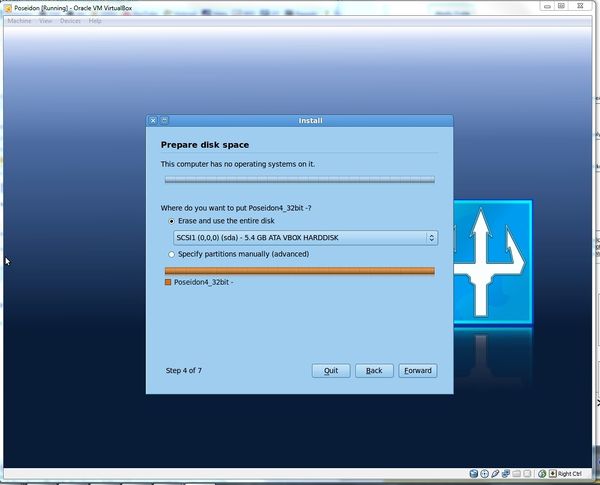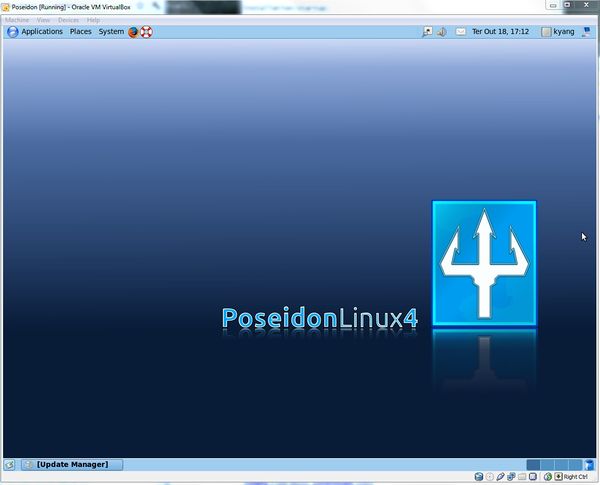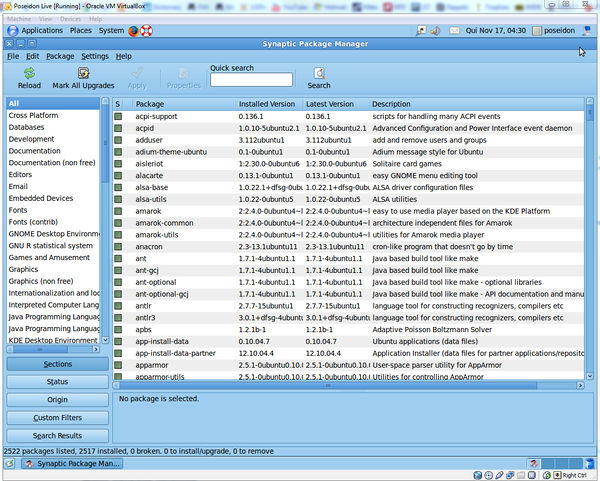COMP 3000 2011 Report: PoseidonLinux: Difference between revisions
36chambers (talk | contribs) No edit summary |
36chambers (talk | contribs) |
||
| Line 49: | Line 49: | ||
=Part II= | =Part II= | ||
==Software Packaging== | ==Software Packaging== | ||
[[File:Synaptic.jpg]] | [[File:Synaptic.jpg|600px|center]] | ||
==Major Package Version== | ==Major Package Version== | ||
Revision as of 03:33, 17 November 2011
Part I
Background
The distribution is named Poseidon Linux, and was created by a team of Brazilian scientists, most of whom are oceanographers and marine biologists. The development team consists of five people, with contributions from quite a few others.
The target audience for this distribution is the scientific community, and many of the programs that come pre-installed are intended for academic and scientific use. It includes many different specialized software that aren’t available in the Ubuntu\Debian repositories, and thereby provides a useful collection of programs. The specialized programs pertain to subjects such as math and statistics, computer-aided design, multi-dimensional graphical visualization, chemistry, and bioinformatics. I obtained the operating system by downloading it from the Poseidon Linux homepage at: https://sites.google.com/site/poseidonlinux/download As of now, the most recent version of the operating system is Poseidon Linux 4.0, and though it is only available in 32 bits at the moment, there are promises of a 64 bit version in the future. An older version of the operating system, Poseidon Linux 3.2, is also available for download. The size of the image file for Poseidon Linux is around 3.7 GB, and when fully installed, requires at least 9.8 GB of hard drive space. Poseidon Linux was originally derived from Kurumin Linux, though Kurumin was officially discontinued on January 29, 2009, after which Poseidon became based on Ubuntu, with the first Ubuntu based release being Poseidon 3.0. Poseidon 3.0 was based on Ubuntu 8.04 LTS, whereas version 4.0 was based on Ubuntu 10.04.
Installation/Startup
I installed Poseidon Linux using Virtual Box. When setting up the new virtual machine in VirtualBox, I allocated 4GB of ram, set the file type of the new virtual disk as .VDI, and set the virtual disk file to use dynamically allocated space. After creating the virtual machine and specifying its settings, I ran the machine, selected the image file containing Poseidon, and begain the installation (screenshots below). A minor issue I came across during installation was my hard drive not having enough space left for Poseidon to install. This problem was quickly fixed after I reluctantly deleted a few legally downloaded movies on my hard drive to free up enough space for the installation.



Basic Operation
Due to the subject specialization of most of the programs and the knowledge required to use them to their respective potentials as intended, I’m unable to adequately review the programs and give a detailed analysis of how useful or well made these programs are (see fig. 1). In retrospect, it was unwise to choose a distribution based on coolest sounding name rather than practical usage.
Aside from the inherent complexity of many of the programs that came with Poseidon, many of the listed programs simply do not execute when selected. The most noticeable disappointment among the inactive/broken/not-yet-implemented programs was the OpenUniverse Space Simulator, which by merit of name alone was obviously intended to be the high point of Poseidon’s entire existence (see fig. 2).
(Fig. 1)

(Fig. 2)

Other non functioning programs include Stellarium, presumably another failed space simulator, and PyMol Molecular Graphics System, a program listed under Bioinformatics. Aside from the programs targeting Poseidon’s main audience, there are programming IDEs like Eclipse and QT Creator, audio/video/image editing programs like Audacity, Pitivi Video Editor, and GIMP, office applications that include an assortment of LibreOffice programs, and 3d graphics modeling programs like Blender.
The first working program I tested was GPeriodic, which is a periodic table of the elements that allows the user to select any element on the table to view more detailed information about it. Such a program is of obvious value to anyone who is using Poseidon for scientific purposes, particularly those doing chemistry. The second program I tested was called fityk, a data analysis program with a poorly chosen name. Since it claimed to do data analysis and had numbers everywhere, I figured it was legit. It also allows the user to select from a long list of function types, from quadratic to exponential decay. After this, the rest of the programs under Applications => Poseidon become even more obscure and complicated, though of no fault of its own considering that Poseidon is advertised to have a rather specific purpose, geared toward the scientific community.
Usage Evaluation
Given that several programs simply don’t work, it is obvious that Poseidon falls somewhat short of its design goals. These errors will presumably be fixed in future updates/versions, though for the time being, there are many other working programs that are quite unique and are assumed to be very useful to users who are looking for the programs designed for very specific uses in the areas of mathematics/statistics, chemistry, bioinformatics, and GIS/CAD (computer aided design). The non working programs indicate that Poseidon is still in an unfinished state, which leaves a slightly disappointing impression, though aside from that, the Poseidon has nice presentation with an appealing default desktop background and a clean interface in general. The list of programs Poseidon features gives anyone who knows how to use them a wide variety of tools at their disposal.
To Poseidon’s target audience who can look past superficial flaws like absence of promised space simulators and a few missing programs, Poseidon has enough math and science related programs to provide at least some level of usefulness towards anyone who would require such programs. Poseidon delivers on it’s promise as a distribution designed for academic and scientific use.
Part II
Software Packaging

Major Package Version
Initialization
References
1) "Poseidon Linux." Wikipedia, the Free Encyclopedia. Web. 20 Oct. 2011.
2) "DistroWatch.com: Poseidon Linux." DistroWatch.com: Put the Fun Back into Computing. Use Linux, BSD. Web. 20 Oct. 2011.
3) "Https://sites.google.com/site/poseidonlinux/." Web. 20 Oct. 2011.
4) "First Look at Poseidon Linux, the Linux For Scientists | Linux.com." Linux.com | The Source for Linux Information. Web. 20 Oct. 2011.
5) EasyBib: Free Bibliography Maker - MLA, APA, Chicago Citation Styles. Web. 20 Oct. 2011.
